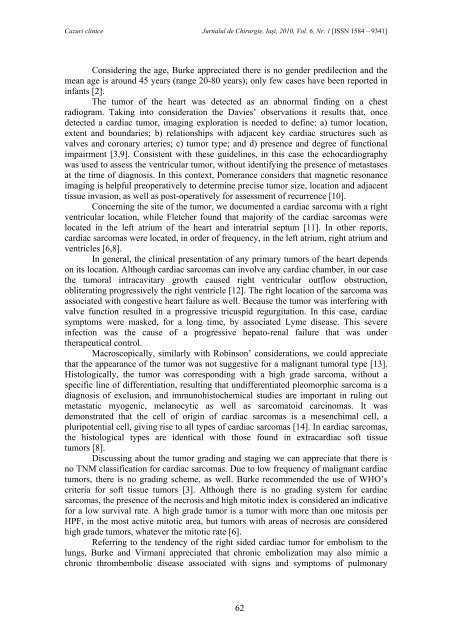Full text PDF (5 MB) - Jurnalul de Chirurgie
Full text PDF (5 MB) - Jurnalul de Chirurgie
Full text PDF (5 MB) - Jurnalul de Chirurgie
You also want an ePaper? Increase the reach of your titles
YUMPU automatically turns print PDFs into web optimized ePapers that Google loves.
Cazuri clinice <strong>Jurnalul</strong> <strong>de</strong> <strong>Chirurgie</strong>, Iaşi, 2010, Vol. 6, Nr. 1 [ISSN 1584 – 9341]<br />
Consi<strong>de</strong>ring the age, Burke appreciated there is no gen<strong>de</strong>r predilection and the<br />
mean age is around 45 years (range 20-80 years); only few cases have been reported in<br />
infants [2].<br />
The tumor of the heart was <strong>de</strong>tected as an abnormal finding on a chest<br />
radiogram. Taking into consi<strong>de</strong>ration the Davies’ observations it results that, once<br />
<strong>de</strong>tected a cardiac tumor, imaging exploration is nee<strong>de</strong>d to <strong>de</strong>fine: a) tumor location,<br />
extent and boundaries; b) relationships with adjacent key cardiac structures such as<br />
valves and coronary arteries; c) tumor type; and d) presence and <strong>de</strong>gree of functional<br />
impairment [3,9]. Consistent with these gui<strong>de</strong>lines, in this case the echocardiography<br />
was used to assess the ventricular tumor, without i<strong>de</strong>ntifying the presence of metastases<br />
at the time of diagnosis. In this con<strong>text</strong>, Pomerance consi<strong>de</strong>rs that magnetic resonance<br />
imaging is helpful preoperatively to <strong>de</strong>termine precise tumor size, location and adjacent<br />
tissue invasion, as well as post-operatively for assessment of recurrence [10].<br />
Concerning the site of the tumor, we documented a cardiac sarcoma with a right<br />
ventricular location, while Fletcher found that majority of the cardiac sarcomas were<br />
located in the left atrium of the heart and interatrial septum [11]. In other reports,<br />
cardiac sarcomas were located, in or<strong>de</strong>r of frequency, in the left atrium, right atrium and<br />
ventricles [6,8].<br />
In general, the clinical presentation of any primary tumors of the heart <strong>de</strong>pends<br />
on its location. Although cardiac sarcomas can involve any cardiac chamber, in our case<br />
the tumoral intracavitary growth caused right ventricular outflow obstruction,<br />
obliterating progressively the right ventricle [12]. The right location of the sarcoma was<br />
associated with congestive heart failure as well. Because the tumor was interfering with<br />
valve function resulted in a progressive tricuspid regurgitation. In this case, cardiac<br />
symptoms were masked, for a long time, by associated Lyme disease. This severe<br />
infection was the cause of a progressive hepato-renal failure that was un<strong>de</strong>r<br />
therapeutical control.<br />
Macroscopically, similarly with Robinson’ consi<strong>de</strong>rations, we could appreciate<br />
that the appearance of the tumor was not suggestive for a malignant tumoral type [13].<br />
Histologically, the tumor was corresponding with a high gra<strong>de</strong> sarcoma, without a<br />
specific line of differentiation, resulting that undifferentiated pleomorphic sarcoma is a<br />
diagnosis of exclusion, and immunohistochemical studies are important in ruling out<br />
metastatic myogenic, melanocytic as well as sarcomatoid carcinomas. It was<br />
<strong>de</strong>monstrated that the cell of origin of cardiac sarcomas is a mesenchimal cell, a<br />
pluripotential cell, giving rise to all types of cardiac sarcomas [14]. In cardiac sarcomas,<br />
the histological types are i<strong>de</strong>ntical with those found in extracardiac soft tissue<br />
tumors [8].<br />
Discussing about the tumor grading and staging we can appreciate that there is<br />
no TNM classification for cardiac sarcomas. Due to low frequency of malignant cardiac<br />
tumors, there is no grading scheme, as well. Burke recommen<strong>de</strong>d the use of WHO’s<br />
criteria for soft tissue tumors [3]. Although there is no grading system for cardiac<br />
sarcomas, the presence of the necrosis and high mitotic in<strong>de</strong>x is consi<strong>de</strong>red an indicative<br />
for a low survival rate. A high gra<strong>de</strong> tumor is a tumor with more than one mitosis per<br />
HPF, in the most active mitotic area, but tumors with areas of necrosis are consi<strong>de</strong>red<br />
high gra<strong>de</strong> tumors, whatever the mitotic rate [6].<br />
Referring to the ten<strong>de</strong>ncy of the right si<strong>de</strong>d cardiac tumor for embolism to the<br />
lungs, Burke and Virmani appreciated that chronic embolization may also mimic a<br />
chronic thrombembolic disease associated with signs and symptoms of pulmonary<br />
62

















